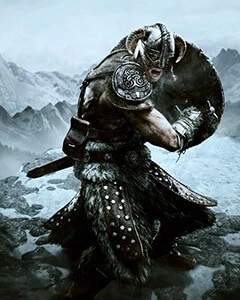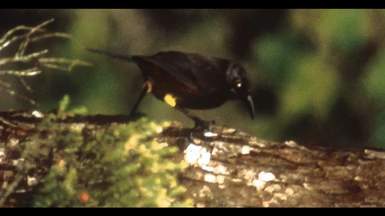About this mod
A small tribute to the late Kauai ʻōʻō: it is now possible to hear the extinct bird sing sporadically in the pine forests. It may be gone from the real world, but it will forever live in the magical world of Skyrim.
- Permissions and credits
- Donations

- If you use, like and value my work, please consider giving an endorsement. I've worked hard for years to offer you the best of me for free, and the only thing I ask in return is this gesture, which increases my relevance and engagement on Nexus, and motivates me to continue;
- I do not inspect or have any influence over translations of my mods (including those linked directly on my pages), nor do I have any power over patches or add-ons made to my content. So, before using any unofficial add-ons for my mods, make sure they conform to the latest version of my official release, and never use these if they don't. The same applies to Xbox ports;
- In addition to the Nexus, you can also find me on:



- Do you have any doubt? Read my Frequently Asked Questions (FAQ).


A small tribute to the late Kauai ʻōʻō: it is now possible to hear the extinct bird sing sporadically in the pine forests. It may be gone from the real world, but it will forever
live in the magical world of Skyrim.
A sad case of the destructive human impact on the environment, this bird native to the islands of Hawaii, specifically Kauaʻi, now considered extinct after being unseen for nearly 40 years, is a symbol of the urgent need to preserve the species. Unfortunately, not just it, but all members of the family to which the bird belonged, and which inhabited the other islands of the archipelago, are now extinct.
The bird became well known on the internet and provoked the sadness and reflection of thousands, if not millions, who saw both the last recorded video of it, and the last record of the song of a lonely male in search of a female that would never arrive.
More detailed information can be found below:
(source: Wikipedia)

(photo by Mark Collins)
"The bird was endemic to the island of Kauaʻi. It was common in the subtropical forests of the island until the early twentieth century, when its decline began. It was last seen in 1985, and last heard in 1987. The causes of its extinction include the introduction of predators (such as the Polynesian rat, small Indian mongoose, and the domestic pig), mosquito-borne diseases, and habitat destruction. It was the last surviving member of the Mohoidae, which had originated over 15-20 million years prior during the Miocene, with the Kauaʻi ʻōʻō's extinction marking the only extinction of an entire avian family in modern times ("modern" meaning post-1500 AD)."
(small documentary showcasing the last video and audio recordings from mid 80's)
The bird was a cavity nester in the thickly forested canyons of Kauaʻi. All of its relatives have also become extinct, such as the Hawaiʻi ʻōʻō, Bishop's ʻōʻō, and Oʻahu ʻōʻō. Relatively little is known about these extinct birds. The species became extinct from a large range of problems, including mosquito-transmitted diseases (which caused the species to retreat to higher ground, ultimately retreating to high-altitude montane forests in the Alakaʻi Wilderness Preserve), introduction of mammalian predators, and deforestation. Higher elevation forests lack tree cavities, so few, if any, nests could be made. As of the early 1960s, the bird had an estimated population of about 34 living individuals. In the 1970s, the only known footage of the bird was filmed by John L. Sincock on Super 8 film and several song recordings were made as well (with Harold Douglas Pratt, Jr. being one of the people involved in recording the songs). In 1981, a pair was found.
The final blow were two hurricanes, Iwa and Iniki, coming within ten years of each other. They destroyed many of the old trees with cavities, and prohibited tree growth when the second one arrived, causing the species to disappear. As a result, the last female bird disappeared (likely killed by Hurricane Iwa). The male bird was last sighted in 1985, and the last sound recording was made in 1987 by David Boynton. After failed expeditions in 1989 and Hurricane Iniki in 1992, the species was declared extinct by the IUCN in 2000.
It is still believed by some that the species may survive undetected, as the species had already been proclaimed extinct twice: once in the 1940s (later rediscovered in 1960) and again from the late 1960s to the early 1970s, being rediscovered by the wildlife biologist John Sincock. However, it has a loud and distinctive call, and intensive surveys that occurred from 1989 to 2000 failed to find any."
As always, I also tried to introduce the bird (even if just the song) in a lore
friendly way, as you can check on the description below:
"The very beautiful birds of the ʻōʻō or Moho family unfortunately had a fate diametrically opposed to their beauty: these nectarivores native to the Systres archipelago, a group of islands in the Abecean Sea, far to the southwest of Hammerfell and northwest of Summerset Isle, found all their extinction, for several reasons, with the Kaua'i 'o'o being the last to be declared gone, a few decades ago.
Native to the islands of Galen and Y'ffelon, the last remaining specimens of a population already shaken by the natural dangerous volcanic activity of Y'ffelon, which also punishes a portion of Galen, had their end caused by weather events that mixed both hurricanes and volcanic eruptions, decimating good part of the life on the two islands. Some are rumored to have survived in the highest mountains of Galen, but none have been heard or seen, even though their song was admittedly loud.
In addition, several factors were already decimating the population, as they did to the various other species of the same family on the several islands of the archipelago, from the introduction of exotic predatory species, to the extermination for food and for the sale of feathers, since these had high ritualistic value, which especially decimated the population of the prison island of Amenos, since the prisoners specialized in hunting these birds indiscriminately. There are rumors that some descendants of the Druids of Galen who would have migrated to Skyrim would have brought some specimens of Kauaʻi ʻōʻō, which would then have reproduced in the hottest and most forested regions of the province, but, apart from one or another traveler who claims to have heard their song, and had the rare chance of hearing one of these birds still alive decades ago in Galen or Y'ffelon to identify the call, little further evidence exists that the bird may still exist.
by Beastmaster Mihail *
(*Who is Beastmaster Mihail? He is my avatar/persona within the universe composed of all my mods. He is the ingame author who writes the texts that are usually presented as descriptions for my mods. A former monster hunter, now a dedicated scholar, he is planned to be released as an NPC in late 2022/early 2023, doing the same job in-game as my descriptions do on Nexus.)

- It is now possible to hear, rarely and randomly, the chant of lone Kaua'i 'o'o calling for mates, in the pine forests of Skyrim.

So far no incompatibilities have been found between this mod and other mods.
(OBS- If by chance when installing several of Mihail's mods at the same time you are asked about files overwriting those of other Mihail mods or other authors mods, don't worry because they are just the same files shared between mods. I recommend that on these occasions always give preference to the files contained in my mods, and among mine always give preference to the mod you are installing last.)

The Easter Eggs series aims to bring to the world of Skyrim fun (or not) easter eggs from the franchise itself, as well as from other game franchises, books, movies, and even cultural references, always in an immersive and zealous way.

Author:
Mihail- minor audio editing to improve the quality of the original recording, game implementation;
Some assets used on this mod belong to:
The last recording of the bird singing was made in 1987 by David Boynton (August 30, 1945 – February 10, 2007), a leading expert on the natural history of the Hawaiian island of Kauai, especially on the Koke'e Forest and the Alakai Swamp and its wildlife.










